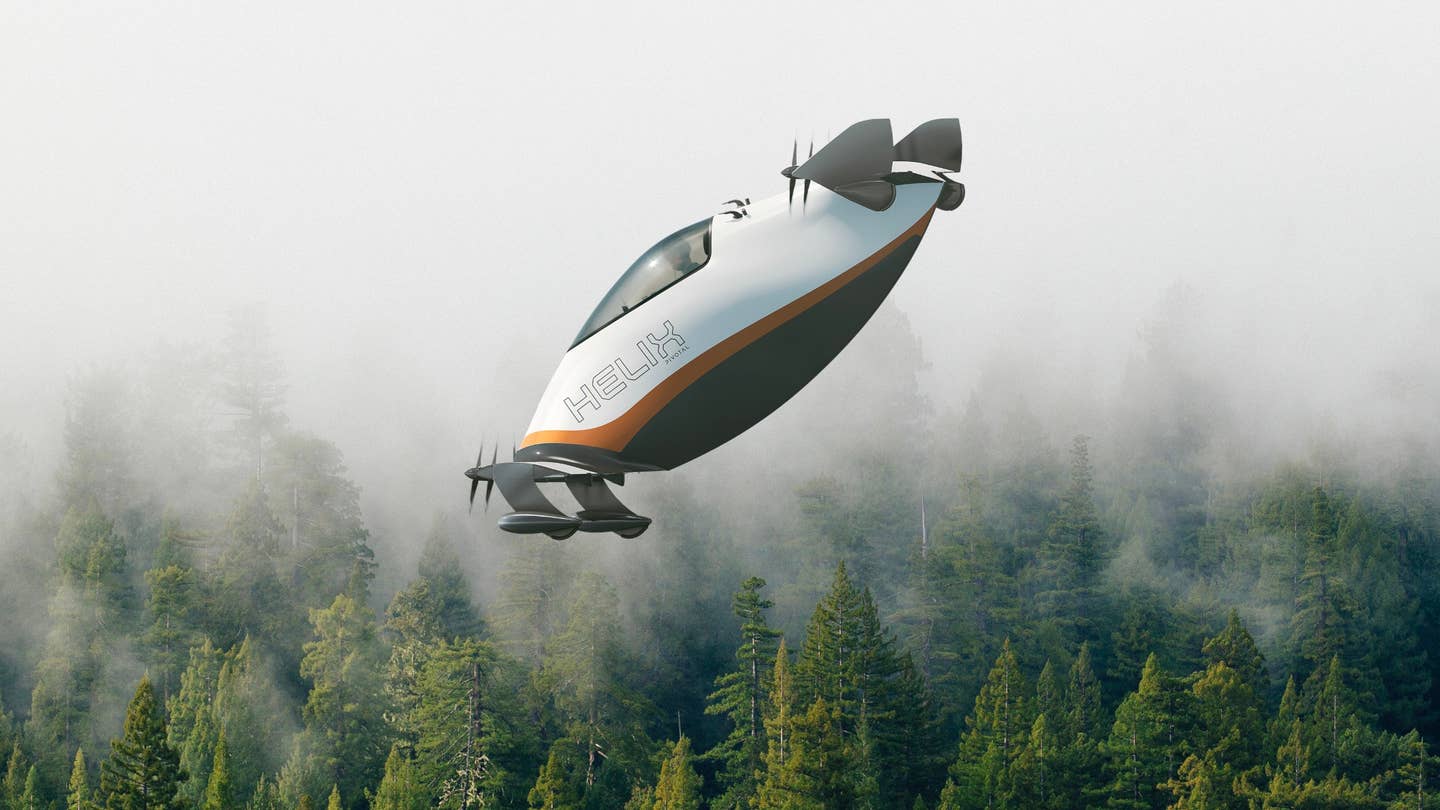Personal Aircraft Requiring No Certificate to Fly Hits U.S. Market
Pivotal’s Helix is an electric vertical takeoff and landing design that qualifies as a Part 103 ultralight built for recreational flyers.

A digital rendering of Pivotal’s Helix, a personal eVTOL aircraft that requires no certificate to fly and is now on sale in the U.S. [Courtesy: Pivotal]
If you’ve dreamed of taking to the skies but are too busy to put in the hours for a full program of flight training, there’s a strange new aircraft you can fly without a certificate—and it’s now on sale in the U.S.
Electric vertical takeoff and landing (eVTOL) aircraft manufacturer Pivotal this week opened online sales of Helix, a personal flying vehicle for first-time aviators and experienced pilots alike. Like a video game, Helix is controlled by a single pilot using a pair of simple joysticks, plus fly-by-wire controls. For $190,000, Pivotal will train customers to fly it and send them on their way in their very own aircraft.
Pivotal, which is backed by Google co-founder and ex-CEO Larry Page, unveiled Helix in October when it rebranded from Opener Aero. Prior to that, the firm actually sold half a dozen preproduction BlackFly aircraft. In June, it said it was the first company to actually deliver an eVTOL to a paying customer.
Helix, which unlike BlackFly is scalable for production, was designed mainly for personal or recreational use. The aircraft is available in three differently priced configurations, with initial customer shipments scheduled for June.
With an empty weight below 350 pounds, Helix qualifies as a Part 103 ultralight aircraft, meaning the FAA does not require pilot certification to fly it. In lieu of hundreds of hours of flight training, Pivotal requires customers to complete about two weeks of initial training at its Palo Alto, California, headquarters, with recurrent training after they earn their wings.
While more expensive than a typical automobile, Helix’s $190,000 base price tag is at the low end of the range for popular personal aircraft. It costs slightly more than a Texas Aircraft Colt, for example, but less than a Beechcraft G36 Bonanza, Diamond DA40 NG, Piper Archer LX, or Cessna models such as the 182 Skylane or 172 Skyhawk.
"We're proud to begin selling, and soon delivering, our Helix aircraft,” said Ken Karklin, CEO of Pivotal. “The market is ready for the wonder of aerial recreation and short-hop eVTOL travel. We are ready to provide the beauty and freedom of personal flight to a whole lot of people with a passion for flying and an interest in creating a new generation of aviators and aviation,”
To fly Helix, owners must be at least 18 years old, weigh less than 220 pounds, and stand no taller than 6-foot-5. Customers can place a nonrefundable $250 application fee on Pivotal’s website. To lock up a production slot and receive a forecasted ship date, they’ll need to deposit another $50,000 within five business days of the initial order.
Full Tilt
There’s nothing quite like Helix flying today.
One of the more eye-catching features is its “tilt aircraft” architecture. Tilting rotors or propellers are not uncommon to eVTOL designs, aiding in both vertical and horizontal flight. Pivotal, however, decided to scrap the moving parts and tilt the entire carbon fiber composite airframe between takeoff and cruise—this, it says, reduces weight, complexity, and points of failure.
Helix relies entirely on propulsion for hover but can cruise on its fixed wings, flying quieter than even an electric car. To switch flight modes, users simply push a button on one of the two joysticks and pull back. The transition happens pretty quickly, as seen below:
Ease of use was a central tenet in Helix’s design: It enables both autotakeoff and autolanding, for example. An integrated display and user interface, meanwhile, give the pilot real-time altitude, location, speed, and other measurements.
Helix represents a major upgrade on BlackFly, with a redesigned canopy and flight deck, more comfortable seating, and improved power, propulsion, and performance. But it maintains its predecessor’s portability, capable of fitting into a 16-foot trailer and going from storage to the sky in less than 30 minutes.
Owners will be able to download a free smartphone app that simplifies preflight checks, captures flight history, and manages charging and aircraft service. Aircraft add-ons include a transport trailer; fast charging; aviation and ground radios; ADS-B; and a gimbal camera, which would allow someone on the ground to watch the flight as if they’re in the air with the pilot.
As a Part 103 ultralight, Helix speeds up time to fly in exchange for certain operational restrictions. For example, pilots will be required to fly during daytime and in Class G airspace, far from congested airspace and airports. The aircraft is also restricted to about a 20 sm (17 nm) range and 63 mph (55 knot) cruise speed.
Since the eVTOL is built for inexperienced flyers, Pivotal made sure to load it with safety features. When necessary, it can land on water, for example, and only six of its eight rotors are required for flight and landing, in addition to other fault-tolerant systems. A landing camera, beacon lights, and whole-aircraft ballistic parachute add further layers of protection.
Starting only in the U.S., Helix can be purchased in three configurations. The $190,000 base package includes a digital flight panel, canopy, HD landing camera, charger, vehicle cart, custom marking, comprehensive pilot training, and warranty. A $240,000 package comes with a glossier finish and all of the features above, plus even more. The priciest option, at $260,000, includes everything in the first two packages plus premium features, such as beacon aircraft lighting, and the option to fully customize the exterior for an added fee.
Pivotal may provide a good litmus test for the integration of outlandish new aircraft such as Helix into airspace used by GA traffic. But Karklin told FLYING the company may one day certify Helix as a light sport aircraft (LSA) under updated FAA rules, should they come to fruition. That could enable some commercial applications, and the Pivotal CEO listed public service and defense as possible future use cases.
Like this story? We think you'll also like the Future of FLYING newsletter sent every Thursday afternoon. Sign up now.

Sign-up for newsletters & special offers!
Get the latest FLYING stories & special offers delivered directly to your inbox






